Oct 13, 2010
Drilling go-ahead in Gulf criticized
By Kara Rowland, Washington times
The Obama administration on Tuesday said it would lift the deep-water drilling moratorium it imposed after the massive BP oil spill, but Gulf of Mexico region lawmakers and industry advocates said the stiffer new rules that the government is imposing will leave rigs idle and workers out of jobs for months longer.
While government officials billed the new policy as a cautious yet pragmatic response to the worst oil spill in the nation’s history, environmental groups accused the White House of caving to political pressure three weeks before the midterm elections.
Interior Department Secretary Ken Salazar said a slate of new government rules on drilling and spill containment has reduced the risks of another spill, enabling him to lift the moratorium, which local leaders say has ravaged the region’s economy and sent jobs overseas. The ban was originally scheduled to end Nov. 30, weeks after the election.
“At this point, we believe the strengthened safety measures we have implemented, along with improved spill-response and blowout-containment capabilities, have reduced risks to a point where operators who play by the rules and clear the higher bar can be allowed to resume,” Mr. Salazar said.
Under the new government rules, drill-rig operators must submit to extensive physical inspections, provide detailed projections of a worst-case spill scenario and certify that rig workers are properly trained. Drilling companies’ top executives also must certify they have complied with the new rules - a way of imposing personal responsibility for their companies’ activities.
Mr. Salazar predicted he would draw criticism from both sides of the issue. He was right.
“Today’s decision is a good start, but it must be accompanied by an action plan to get the entire industry in the Gulf of Mexico back to work,” said Sen. Mary L. Landrieu, Louisiana Democrat, a fierce critic of the moratorium. “This means that the administration must continue to accelerate the granting of permits in shallow and deep water, and provide greater certainty about the rules and regulations industry must meet.”
Mrs. Landrieu said the announcement does not go far enough for her to release her legislative hold on Jacob Lew, President Obama’s nominee to be the new White House budget director. Likewise, Gulf State Republicans warned the new rules could create a bureaucratic bottleneck by being too onerous for drilling operators to comply with, saying it could be several months before their new applications are approved.
“It’s clear that President Obama is going to preside over a continuing de facto moratorium for months or years, with new drilling held back to a fraction of previous levels,” Louisiana’s other senator, David Vitter, said.
The pro-industry Institute for Energy Research said the move amounted to a “permitorium” on deep-water drilling.
“Today’s announcement is about politics and headlines, not getting folks back to work and increasing domestic energy exploration and production in the United States,” IER President Thomas J. Pyle said. “What was announced today will result in no change in domestic energy production in the Gulf of Mexico until Interior Secretary Salazar begins to issue permits once again. In the meantime, thousands of Gulf Coast families will continue to be out of work. It can’t be explained any other way.”
Mr. Salazar said he based his decision on a report by Michael Bromwich, director of the Bureau of Ocean Energy Management, Regulation and Enforcement, which laid out a series of recommendations on how to improve the safety of drilling in the wake of the April 20 explosion of the Deepwater Horizon oil rig off the coast of Louisiana.
Asked by reporters how long it will take the 36 oil rigs that were affected by the moratorium to come back online, Mr. Bromwich said it’s anybody’s guess, but that the timeline depends mostly on how long it takes firms to ensure they are in compliance with the new rules.
“It will clearly not be tomorrow, and it is not going to be next week,” he said, adding that it’s “my sense that we will have permits approved by the end of the year.”
Greenpeace USA criticized the administration as capitulating to “big oil.”
“This is pure politics of the most cynical kind. It is all about the election season, not safety and environmental concerns. The White House wants us to believe that they have solved all the dangers of offshore drilling and we can return to business as usual. It is a false promise, if not a big lie,” Executive Director Philip Radford wrote in an article on Huffington Post on Tuesday.
But White House press secretary Robert Gibbs insisted that political pressure had nothing to do with Mr. Salazar’s announcement, calling it “part of the natural policy process” that resulted from the government’s months-long review of deep-water drilling safety.
The ban drew a series of legal challenges from drilling companies and state governments, with varying degrees of success.
A judge blocked Mr. Salazar’s first attempt, announced in May, to halt drilling in waters deeper than 500 feet. Judge Martin L.C. Feldman said the ban was unjustified and that it appeared to have been prompted more by politics than science.
Mr. Salazar withdrew that first moratorium and replaced it with another one, which he said was tailored specifically to high-risk drilling rigs. But drillers challenged the new ban, too, arguing it applied to exact the same number of rigs, suggesting the second ban was purely meant to sidestep the court’s ruling.
On Tuesday, Mr. Salazar submitted a request telling Judge Feldman the moratorium has been lifted and asking him to keep that in mind as he considers what to do with the case.
Stephen Dinan contributed to this article.
Oct 09, 2010
Dangerous Carbon Pollution: Propaganda from Climatism
by Steve Goreham
In an address to Green Mountain College on May 15, Carol Browner, Director of Energy and Climate Change Policy, stated “The sooner the U.S. puts a cap on our dangerous carbon pollution, the sooner we can create a new generation of clean energy jobs here in America...” In July, 2009, President Obama lauded the “Cash for Clunkers” program, stating that the initiative “gives consumers a break, reduces dangerous carbon pollution, and our dependence on foreign oil....” Unfortunately, our President is misinformed about carbon pollution.
The phrase “dangerous carbon pollution” has become standard propaganda from environmental groups. An example is a May, 2010 press release from the World Wildlife Fund that called for “a science-based limit on dangerous carbon pollution that will send a strong signal to the private sector.”
Environmentalists have successfully painted a picture of black particle emissions into the atmosphere. This misconception is being used to drive efforts for Cap & Trade legislation, renewable energy, and every sort of restriction on our light bulbs, vehicles, and houses. All in the misguided attempt to stop climate change.
Carbon is integral to our skin, our muscles, our bones, and throughout the body of each person. Carbon forms more than 20% of the human body by weight. We are full of this “dangerous carbon pollution” by natural metabolic processes.
It’s true that incomplete combustion emits carbon particles that can cause smoke and smog. But this particulate carbon pollution is well controlled by the Clean Air Act of 1970 and many other federal and state statutes.
According to Environmental Protection Agency data, U.S. air quality today is significantly better than it was in 1980. Since 1980, airborne concentration of carbon monoxide is down 79%, lead is down 92%, nitrogen dioxide is down 46%, ozone is down 25%, and sulfur dioxide is down 71%. Carbon particulates have been tracked for fewer years, but PM10 particulates are down 31% since 1990 and PM2.5 particulates are down 19% since 2000. Over the same period, electricity consumption from coal-fired power plants rose 72% and vehicle miles driven are up 91%. We do not need Cap & Trade, Renewable Portfolio Standards, or the California Global Warming Solutions Act (AB32), to reduce carbon particulates. Graph below, enlarged here.
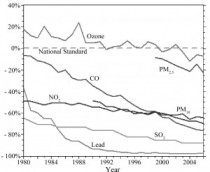
Climatism! Science, Common Sense, and the 21st Century’s Hottest Topic, Figure 78, data from EPA, 2006
The target of “dirty carbon pollution” propaganda is carbon dioxide. Carbon dioxide is an invisible, odorless, harmless gas. It does not cause smog or smoke. Humans breathe out 100 times the CO2 we breathe in, created as our body uses sugars. But since it’s tough to call an invisible gas “dirty,” Climatists use “carbon” instead. It’s as wrong as calling water “hydrogen” or salt “chlorine.” Compounds have totally different properties than their composing elements.
Not only is carbon dioxide not a pollutant, it’s essential for life. As pointed out by geologist Leighton Steward, carbon dioxide is green! Carbon dioxide is plant food. Increased atmospheric CO2 causes plants and trees to grow faster and larger, increase their root systems, and improve their resistance to drought, as documented by hundreds of peer-reviewed scientific papers. Carbon dioxide is the best compound that mankind could put into the atmosphere to grow the biosphere.
This “carbon pollution” nonsense is driven by Climatism, the belief that man-made greenhouse gases are destroying Earth’s climate. In a debate at the Global Warming Forum at Purdue University on September 27, Dr. Susan Avery, President of the Woods Hole Oceanographic Institution, was asked “What is the strongest empirical evidence that global warming is caused by man-made greenhouse gas emissions rather than natural causes?” Neither Dr. Avery nor Dr. Robert Socolow of Princeton, who also presented, could provide an answer, except the ambiguous “There is lots of evidence.” In fact, Climatism is based largely on computer model projections. There is no empirical evidence that man-made greenhouse gases are the primary cause of global warming. According to Dr. Frederick Seitz, past President of the National Academy of Sciences, “Research data on climate change do not show that human use of hydrocarbons is harmful. To the contrary, there is good evidence that increased atmospheric carbon dioxide is environmentally helpful.”
As Joanne Nova, Australian author, points out: “Everything on your dinner table - the meat, cheese, salad, bread, and soft drink - requires carbon dioxide to be there. For those of you who believe carbon dioxide is a pollutant, we have a special diet: water and salt.” So the next time you drink a beer or eat a meal, beware of that “dangerous carbon pollution.”
Steve Goreham is Executive Director of the Climate Science Coalition of America and author of Climatism! Science, Common Sense, and the 21st Century’s Hottest Topic.
Oct 08, 2010
Dr. Ryan N. Maue’s 2010 Global Tropical Cyclone Activity Update
By Dr. Ryan Maue, Florida State University on SPPI
Update: Current Year-to-Date analysis of Northern Hemisphere and Global Tropical Cyclone Accumulated Cyclone Energy (ACE) AND Power Dissipation Index (PDI) has fallen even further than during the previous 3-years. The global activity is at 33-year lows and at a historical record low where Typhoons form in the Western Pacific.
While the North Atlantic has seen 15 tropical storms / hurricanes of various intensity, the Pacific basin as a whole is at historical lows! In the Western North Pacific stretching from Guam to Japan and the Philippines and China, the current ACE value of 48 is the lowest seen since reliable records became available (1945) and is 78% below normal*. The next lowest was an ACE of 78 in 1998. See figure below for visual evidence of the past 40-years of tropical cyclone activity.
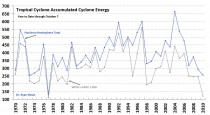
Figure: Year-to-Date (October 7) Accumulated Cyclone Energy (ACE; units: 104 knots2) (enlarged here) for the Northern Hemisphere as a whole (top blue time series) and for the combination of the Western North Pacific (WPAC), Eastern Northe Pacific (EPAC), and Northern Indian (NIO) basins (bottom gray time series). The difference between the two lines is therefore the contribution of the North Atlantic hurricane basin. Similar figure for Power Dissipation Index (units: 106 knots3)
End of September update: The North Atlantic flurry dominates the Northern Hemisphere ACE contribution. But the lack of Pacific activity keeps the NH and global ACE still at 33-year lows. Basins with respect to previous 30-year-to-date averages: Western Pacific 25% Eastern Pacific 44% North Atlantic 164% Northern Hemisphere 63%
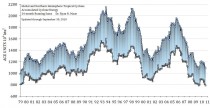
Figure: Global and Northern Hemisphere Accumulated Cyclone Energy: 24 month running sum (enlarged here) through September 30, 2010. Note that the year indicated represents the value of ACE through the previous 24-months for the Northern Hemisphere (bottom line/gray boxes) and the entire global (top line/light blue boxes). The area in between represents the Southern Hemisphere total ACE.
Read more here.
Icecap Note: The Atlantic as expected was more active than usual (164% as of end of September) thanks to the warm Atlantic and La Nina. The upper pattern though have prevented landfall although remnants of Nicole ran up the east coast with flooding rains and gusty winds. It was deemed by NHC extratropical at that time its tropical moisture contributed to the flooding rains.
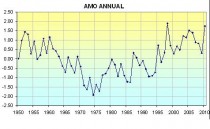
Figure: Annual average AMO (enlarged here)
Update:
“While the North Atlantic has seen 15 tropical storms / hurricanes of various intensity and duration, the Pacific basin as a whole is at historical lows! In the Western North Pacific stretching from Guam to Japan and the Philippines and China, the current ACE value of 48 is the lowest seen since reliable records became available (1945) and is 78% below normal. The next lowest was an ACE of 78 in 1998. The Northern Hemisphere overall (including zthe North Atlantic) has the lowest ACE since 1977, the year of the Great Climate Shift and flip in the phase of the Pacific Decadal Oscillation.”
Note on the EPAC: Typically EPAC activity begins to drop off considerably after the middle of October, and there is nothing currently on the horizon to suggest that a new EPAC TC is in the works. It is very possible that there will be no more named TCs in that basin this season. If so, this will be least active season in terms of number of named storms since 1964. Since 1971, the year in which the best track database is considered somewhat reliable, the lowest number of named storms has been 8, in 1977, a year famous for very low levels of TC activity across the entire Northern Hemisphere. The stats for this season so far are 7 NS, 3 H, and 2 IH.
Note on WPAC: Only 13 named storms so far, less than the Atlantic, and no super typhoons. This basin account for 30% of the annual TC activity. Normal for this basin is 32 named storms!
Oct 07, 2010
Kiwigate is a Carbon Copy of Climategate
John O’Sullivan for SPPIblog
New Zealand climate scientists embroil themselves in as much of a climate data fraud scandal as Climategate and with eerily similar methods and results.
The New Zealand Climate Science Coalition (NZCSC) in its article ‘NIWA Challenged to Show Why and How Temperature Records Were Adjusted’ (February 7, 2010) provides its readers with an insight into the climate scandal dubbed ‘Kiwigate.’
NIWA is New Zealand’s National Institute of Water and Atmospheric Research and is accused of repeatedly frustrating NZCSC in its attempts to get government climatologists to explain how they managed to create a warming trend for their nation’s climate that is not borne out by the actual temperature record.
According to NZCSC, climate scientists cooked the books by using the same alleged ‘trick’ employed by British and American doomsaying scientists. This involves subtly imposing a warming bias during what is known as the ‘homogenisation’ process that occurs when climate data needs to be adjusted.
Homogenisation Explained
When such data adjustments (homogenisations) are made, scientists must keep their working calculations so that other scientists can test the reasonableness of those adjustments. According to an article in Mathematical Geosciences (April 2009) homogenisation of climate data needs to be done because “non-climatic factors make data unrepresentative of the actual climate variation.”
The article tells us that if the raw data is not homogenised (or, in this case, “fudged” according to sceptics) the “conclusions of climatic and hydrological studies are potentially biased.”
According to the independent inquiry into Climategate chaired by Lord Oxburgh, it was found that it was the homogenisation process itself that became flawed because climatologists were overly guided by “subjective” bias.
Andrew Bolt, writing for Australia’s Herald Sun (November 26, 2009) commented that the Kiwigate scandal was not so much about “hide the decline” but “ramp up the rise.”
Jim Salinger: Another ‘Phil Jones’?
Bolt goes on to report, “Those adjustments were made by New Zealand climate scientist Jim Salinger, a lead author for the Intergovernmental Panel on Climate Change (IPCC).” Salinger was dismissed by NIWA this year for speaking without authorisation to the media.
Salinger once worked at Britain’s CRU, the institution at the centre of the Climategate scandal.
Salinger became part of the inner circle of climate scientists whose leaked emails precipitated the original climate controversy in November 2009. In an email (August 4, 2003) to fellow disgraced American climate professor, Michael Mann, Salinger stated he was “extremely concerned about academic standards” among climate sceptics.
Circling The Bandwagons?
NZCSC made a joint press release with the Climate Science Conversation Group (December 18, 2009) accusing NIWA of publishing, “misleading material.” The two organisations claim that NIWA had been “defensive and obstructive” in requests to see New Zealand climate scientists’ data.
NZCSC goes on to report, “The main objective of our temperature study was not to show that the raw data has been tampered with, even though that opinion was emphasised and cannot yet be excluded.”
On January 29, 2010, in what seemed like a reprise of the Phil Jones debacle at Britain’s Climate Research Unit, the Kiwi government finally owned up that “NIWA does not hold copies of the original worksheets.”
Kiwigate Mimics Climategate
Kiwigate appears to match Climategate in three essential characteristics. First, climate scientists declined to submit their data for independent analysis. Second, when backed into a corner the scientists claimed their adjustments had been ‘lost’. Third, the raw data itself proves no warming trend. Thus we may reasonably infer a ‘carbon copy’ of Climategate.
NZCSC explained their frustrations in trying to get to actual truth about what had happened with New Zealand’s climate history, “NIWA did everything they possibly could to help us, except hand over the adjustments. It has turned out that there was actually nothing more they could have done - because they never had the adjustments. None of the scientific papers that NIWA cited in their impressive-sounding press releases contained the actual adjustments.”
After a protracted delay NIWA was forced to admit it has no record of why and when any adjustments were made to the nation’s climate data. Independent auditors have shown that older data was fudged to make past temperature appear cooler, while modern data was inexplicably ramped up to portray a warming trend that is not backed up by the actual thermometer numbers.
Sceptics are asking how can it be that climate scientists in different countries at the opposite side of the world are facing extraordinarily similar data fraud allegations?
Unsatisfactory Outcome
The world is left with more questions than answers. Website,’Scoop’ echoed the sentiments of other climate sceptics by arguing that because New Zealand’s climate data adjustments cannot be verified (peer-reviewed) like CRU’s, then they are thus just as worthless.
With so many climatologists having ‘lost’ their calculations, no one can now replicate their methods and confidence in climate science has evaporated.
In addition, further scandalous revelations with Glaciergate and other ‘gates’ have mired the IPCC in an alleged international data fraud conspiracy that undermines the entire theory of man made climate change.
The knock-on effect worldwide is a fall away in voters’ concerns about ‘global warming’ issues so that international governments are losing their mandate for cap and trade taxes to reduce greenhouse gas emissions from fossil fuels.
References:
Bolt, A. ‘Climategate: Making New Zealand warmer,’ Herald Sun (November 26, 2009), accessed online April 26, 2010.
Costa, A.C. and A. Soares, ‘Homogenization of Climate Data: Review and New Perspectives Using Geostatistics,’ Mathematical Geoscience, Volume 41, Number 3 / April, 2009.
New Zealand Climate Science Coalition, ‘NIWA Challenged to Show Why and How Temperature Records Were Adjusted’ (February 7, 2010), accessed online April 26, 2010.
NZCSC & Climate Science Conversation Group; Press Statement of December 18, 2009; accessed online ( April 26, 2010).
Salinger, J. Climategate email Filename: 1060002347.txt. (August 4, 2003).
See SPPI blog here.
See this detailed report on KIWIGATE here.
Oct 05, 2010
Watts Up With Nuuk?
By Anthony Watts
As regular readers know, I have more photographs and charts of weather stations on my computer than I have pictures of my family. A sad commentary to be sure, but necessary for what I do here.
Steve Goddard points out this NASA GISS graph of the Annual Mean Temperature data at Godthab Nuuk Lufthavn (Nuuk Airport) in Greenland. It has an odd discontinuity:
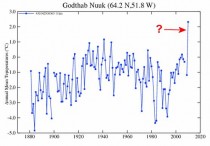
Source data is here
The interesting thing about that end discontinuity is that is is an artifact of incomplete data. In the link to source data above, GISS provides the Annual Mean Temperature (metANN) in the data, before the year 2010 is even complete here.
Yet, GISS plots it here and displays it to the public anyway. You can’t plot an annual value before the year is finished. This is flat wrong.
But even more interesting is what you get when you plot and compare the GISS “raw” and “homogenized” data sets for Nuuk, my plot is below:
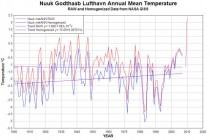
Looking at the data from 1900 to 2008, where there are no missing years of data, we see no trend whatsoever. When we plot the homogenized data, we see a positive artificial trend of 0.74C from 1900 to 2007, about 0.7C per century.
When you look at the GISS plotted map of trends with 250KM smoothing, using that homogenized data and GISS standard 1951-1980 baseline, you can see Nuuk is assigned an orange block of 0.5 to 1C trend.
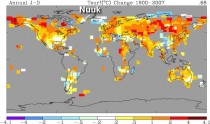
Source for map here
So, it seems clear, that at least for Nuuk, Greenland, their GISS assigned temperature trend is artificial in the scheme of things. Given that Nuuk is at an airport, and that it has gone through steady growth, the adjustment applied by GISS is in my opinion, inverted.
The Wikipedia entry for Nuuk states:
With 15,469 inhabitants as of 2010, Nuuk is the fastest-growing town in Greenland, with migrants from the smaller towns and settlements reinforcing the trend. Together with Tasiilaq, it is the only town in the Sermersooq municipality exhibiting stable growth patterns over the last two decades. The population increased by over a quarter relative to the 1990 levels, and by nearly 16 percent relative to the 2000 levels.
Instead of adjusting the past downwards, as we see GISS do with this station, the population increase would suggest that if adjustments must be applied, they logically should cool the present. After all, with the addition of modern aviation and additional population, the expenditure of energy in the region and the changing of natural surface cover increases.
Read MUCH MORE here.
----------------
ASOS rounds temperatures UP resulting in a warm bias, how convenient
By E.M. Smith
In this post here, I found a roughly 1 F high bias to the ASOS at San Jose, and that led to finding out that the ASOS system rounds UP to whole degrees C.
Given that ASOS are now used as the QA standard for the daily data in USHCN (and who knows where else...) and that ASOS are an increasing percentage of the data over time, this could be significant.
See the documentation from NOAA here.
The methods used by ASOS and observers to measure maximum and minimum temperatures are somewhat similar. ASOS software uses an algorithm that samples the ambient air temperature nominally every 30 seconds and computes a one minute average based on this reading. It then averages five consecutive one minute values to compute a five minute ambient air temperature. This temperature is updated every minute. The highest and lowest five minute average temperatures of the day are stored as the maximum and the minimum temperatures, respectively. All values are rounded up (NOAA et al. 1992).
See much more on the E.M. Smith post on Chiefio here.
|









